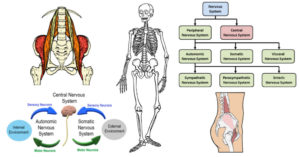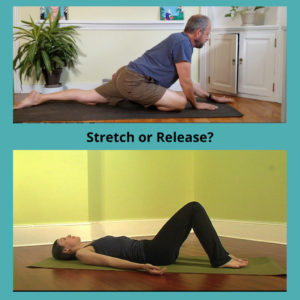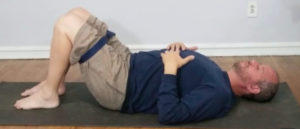Constructive Rest Position: What Is A Release?
 Constructive rest is the go-to pose I use for helping people deal with chronic pain issues.
Constructive rest is the go-to pose I use for helping people deal with chronic pain issues.
Created by Lulu Sweigard, this simple position allows the body to relax. And when it comes to chronic pain and trauma relaxing the body and mind is everything.
The genius of the shape is its simplicity.
I’ll quote Sweigard from her book Human Movement Potential:
“The distribution of structural weight should balance the body so that no muscle work need be added to maintain equilibrium in the position.”
That’s a technical way of saying relax (Sweigard is one of my biggest influences).
Chronic pain messes with the nervous system which I will get into below. For some people relaxing the nervous system is more important to pain relief than traditional methods of healing.
Because some people fall through the cracks when seeking relief through regular channels.
The people I refer to, and you might be one, tend to be more sensitive to pain and its consequences.
Have you been down the doctor’s rabbit hole to be told that nothing seems to be wrong?
Which doesn’t suggest they are saying your pain isn’t real. But most doctors need to see and feel concrete issues to be able to diagnose something.
Have you been to physical therapy? For some people, physical therapy works wonders. One prescription and they are good to go.
But for others, physical therapy can be ineffective, or even make things worse.
Finally, have you had MRIs or X-Rays? Often, pain fails to show up on tests.
You might feel like your lower back is broken but often tests come back negative despite your discomfort.
My own pain story that brought me here was literal. I underwent three knee surgeries before realizing that something was definitely wrong.
What I realized was some basic changes were needed if I want to live a life free from pain.
What Is A Psoas?
 My journey to a pain-free life involved a lot of learning. I realized that I was hypermobile and that, coupled with an advanced yoga practice, was killing my joints.
My journey to a pain-free life involved a lot of learning. I realized that I was hypermobile and that, coupled with an advanced yoga practice, was killing my joints.
As a hypermobile person, I locked, or hyperextended, my knees by default.
And I had no idea that I was doing it.
I also walked like a duck with my feet turned out.
Starting with standing and walking I began to learn about this amazing body we have.
Along the way, I discovered a muscle that I consider the most important muscle in the body.
You might guess the heart. Which would be reasonable.
Or the tongue. Another wise option.
But it’s not those muscles.
It is a muscle that lives deep in your core that not enough doctors are talking about.
It is a standing muscle, a walking muscle, and wildly, it is the muscle of pain and trauma.
What’s that you ask? Did I just equate a muscle with trauma?
Well yes, I did and while it might seem a little woo-woo, I think this muscle is the warehouse for unprocessed energy in the body.
Meet the psoas, a muscle involved in almost all of your pain issues, and your doctors probably never mentioned it.
The psoas connects the legs to the spine from the back of the inner thigh to the base of the ribcage. It connects all along the lower spine.
Without going too much into this amazing muscle here, suffice to say it is uniquely connected to the nervous system.
And chronic pain as I will show you is all about a dysfunctional nervous system.
So we will get to constructive rest but first I would like to go a little deeper into the psoas and nervous system.
Trauma and the Psoas– A Complicated Couple
 The nervous system, as you can see in the graphic above, has a lot of divisions. Two of them are particularly important to this discussion.
The nervous system, as you can see in the graphic above, has a lot of divisions. Two of them are particularly important to this discussion.
The sympathetic nervous system and the parasympathetic nervous system.
These two systems work together to create a balance in the nervous system known as homeostasis.
The sympathetic nervous system is related to excitation and is connected to our flight or fight response. Our flight or fight response is essential to our survival.
The parasympathetic nervous system relates to relaxation.
Say you are walking late at night along a well-lit path and you turn down a dark and empty street.
While you were happy and relaxed until you turned, the darkness of the new street turns on warning signals in your brain.
Your mouth goes dry, your pupils dilate, maybe you feel some tingling in your spine. Your hip flexors (the psoas and others) turn on, ready for fight, or flight.
These are all signs that the sympathetic nervous system has kicked in to protect you in case of danger.
But once your eyes adjust to the darkness and you sense that you are safe, the parasympathetic nervous system kicks in and you relax. As it should.
What if all of a sudden there is a noise behind you? The sympathetic nervous system kicks in again to heighten your awareness.
If the noise doesn’t recur the parasympathetic can take over and you relax. This is how it works when things go as they should.
But what if you lived in a war zone, a bad neighborhood, or an emotionally violent household?
In these scenarios, it shouldn’t be hard to imagine the sympathetic nervous system going on high alert and staying there.
And the body’s main hip flexor– the psoas– engages and never turns off.
I refer to this as getting stuck in the sympathetic nervous system. And in this scenario, the parasympathetic can’t turn on to calm us down.
But the energy that we aren’t able to process in this heightened state is still there and needs somewhere to go.
And that somewhere is the psoas, the body’s warehouse for unprocessed energy and trauma.
Stretch or Release: Which is Better?
 I am a yoga teacher. That means I teach people to stretch and strengthen. All day, every day.
I am a yoga teacher. That means I teach people to stretch and strengthen. All day, every day.
Stretching and strengthening make us happier, healthier, more mobile, and the list goes on.
Everyone needs to stretch and strengthen. I have based my life’s work on that premise.
But, and you knew the but was coming…
There are some things that you can’t stretch or strengthen your way out of.
The question is: what are the doctor’s options? If you go in with pain they have a limited menu of to work with.
They can refer you to physical therapy or take a battery of tests like x-rays or MRIs.
Anti-inflammatory meds are an option, or sometimes injections like corticosteroids.
Surgery might be floated as a possibility.
If you don’t respond to these interventions you will likely be sent for other tests in search of an answer.
Traditional methods need concrete answers and can’t really cope with all types of pain.
Chronic pain that won’t resolve due to a nervous system that is out of whack is simply not on their radar.
For those people, and if you got this far, you might be one of them… sometimes you need to do less.
It’s as simple as that. In the next and last section, I’ll lay out how to do constructive rest, the simple yet magical pose that can begin to change everything for you.
First, let’s talk about releases or release poses. We all know what a stretch is but what is a release?
To be honest, it isn’t anything really.
It is simply another name for relaxing.
And if everything I have been writing resonates with you, relaxing by any name, might be exactly what you need.
Finding freedom from chronic pain can be complicated but the solution for it doesn’t have to be.
I teach a number of different “release” poses in my workshop Psoas Release Party! But constructive rest pose in the foundation on which it is all built.
Constructive Rest Pose: Psoas I was Saying
 Constructive rest position is the ultimate psoas release.
Constructive rest position is the ultimate psoas release.
You can relax your psoas to unlock years of chronic pain and tension that has resided deep in your core.
As woo-woo as that sounds I have seen the benefits of this pose take on many forms.
From a benign experience to a body moving in undulating waves, this pose can truly help the body let go.
Many years later this is still the pose I offer more than any other.
Doing nothing for a half-hour isn’t always the easiest thing for people. But if you can, this is the position for you.
Honestly, 5 or 10 minutes would be good as well but the more the merrier.
And I do want to reiterate that I believe in stretching the psoas as well, but everything has its place.
Sometimes you have to release and relax in order to get back to being active.
The idea of the pose is to do nothing. The setup has some specificity but it is pretty darned basic.
It has multiple applications. If you have trouble sleeping do it before you go to bed. If you are in pain when you wake up do it first thing.
If you do work out but think you might have overdone it, do constructive rest.
- Lie on your back with your knees bent and your feet flat on the floor. Your heels are 12 to 16 inches away from your pelvis, in line with your sit bones.
- Tie a belt around the middle of the thighs. You want to be able to relax, and not have to think too much about the position of your legs.
- Then do nothing. Discomfort arises from conditioned muscular patterns. Try not to shift or move when unpleasant sensations arise.
- You are hoping to feel sensations that you can sit with, and if possible, allow to pass.
But you are not here to suffer. If sensations come up and you feel that you have to move, feel free to move. Then come back to where you were and start again.
It’s possible that you’ll do this exercise and not feel anything; it will still be good for you.
There is not much better when it comes to releasing and relaxing the psoas than constructive rest position.
For some, it is an essential first step on the long journey out of chronic pain.
